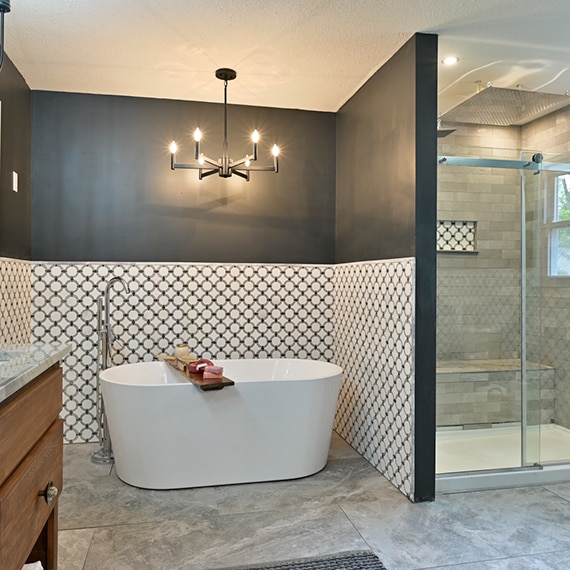
CONCRETE LOOK TILE
• Scratch-resistant
• Stain-resistant
• Fire-resistant
• Slip-resistant
Popular Selections
Concrete Look Tile FAQs
Is it cheaper to tile or stain concrete?
Staining a new concrete floor or refinishing an existing one is between $2 and $25 per square foot. Most tile is priced between $1 to $5 per sq ft. so for DIY projects, tile has a significantly lower cost. Professionally installed tile ranges from $5-$14 per sq ft., making tile less expensive when hiring an installer in many, but not all, cases. These costs vary widely as they are dependent on the size of the space and labor costs in your area. Also, labor cost for smaller spaces is typically higher per square foot.
Is concrete cheaper to install than tile?
If you don't have an existing concrete floor, tile is the less costly option. Installation of concrete runs $4-$30 per sq ft. Professional installation is required for concrete. (This is not a DIY project!) That does not include the cost of any special type of refinishing, staining, or sealing.
Professionally installed tile ranges from $5-$14 per sq ft. Professional installation is recommended but not required. For DIY, most tile is $1-$5 per sq ft. RevoTile was designed to lower installation cost. It needs no mortar, so there is no need to wait for it to cure before grouting (no second trip). RevoTile clicks together, eliminating the need for spacers, which cuts professional installation time (and therefore cost) in half. For do-it-yourselfers, the ClicFit technology assures perfect grout lines and no lippage - key hallmarks of professional installation.
Is concrete harder than porcelain tile?
The opposite is true. Porcelain is heated at extremely high temperatures, making it denser and stronger than any other tile material. Concrete tile can easily crack or chip before installation, but less so once it is installed.
Which is easier to maintain, concrete or porcelain?
Porcelain is easier to maintain. While both concrete (after installation) and porcelain are chip, crack, scratch and dent resistant, only porcelain is waterproof and stain resistant. Moisture can penetrate concrete, weakening it and making it susceptible to mold and mildew. Concrete is also easily stained. In order to avoid these problems, concrete should be sealed before use and waxed or resealed every 3 to 9 months. Porcelain does not require sealing or any maintenance regime other than normal cleaning.
Does tile stick to concrete?
Yes, tile will adhere to concrete. It is recommended that concrete floors be prepared for tile installation by proper cleaning and priming prior to installation. Daltile Sales Service Centers offer a wide range of tile setting and installation products perfect for preparing concrete floors for tile installation.
What are the biggest differences between tile and concrete?
Both are on-trend and offer incredible style. And in fact, it can be difficult to distinguish between concrete tile and concrete look tile. Even poured concrete has a doppelganger in porcelain extra-large slabs but with a LOT less effort to install. (No concrete trucks needed, hallelujah!) The main differences between the two materials are 1) strength, 2) porosity, and 3) required maintenance. Both are strong and both are low-maintenance. However, porcelain is denser, harder and more durable. Concrete is vulnerable to moisture (resulting in mold, mildew, and cracks) and stains, whereas porcelain is stain-resistant and waterproof. Last but not least are maintenance requirements. Concrete must be sealed prior to use and resealed every 3 to 9 months. Porcelain does not need sealing at all.



















